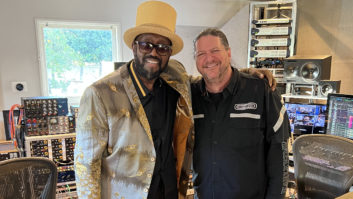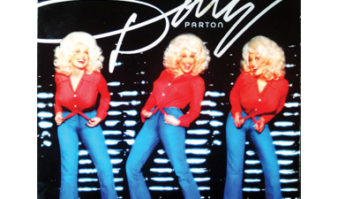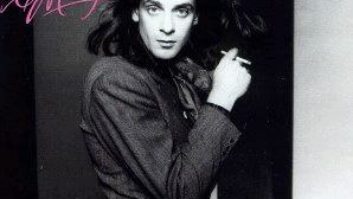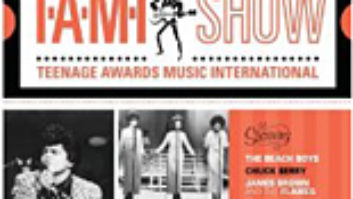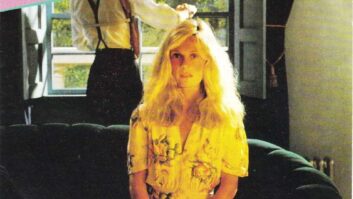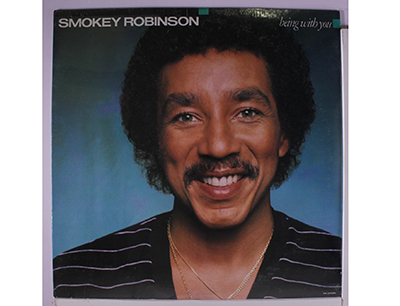
You know a Smokey Robinson song when you hear one. Whether the man himself sings in his own heartbreaking falsetto, or other artists do the honors, Robinson’s songs have their own unmistakable style and rhythm. And one of the many pleasures of seeing Robinson perform live is the chance to hear the composer’s own renditions of the songs he gave away. Listen to the excellent live album BBC Electric Proms 2009: Smokey Robinson, which commemorates Motown’s 50th anniversary; you’ll hear Robinson singing “My Girl,” “The Way You Do the Things You Do” and “Get Ready,” just for instance. This month’s Classic Track is about a song that Robinson intended for another singer but ended up keeping: “Being With You.”
Following his split from The Miracles in 1972, Robinson focused a lot of energy on his duties as a Motown label exec and producer, but he also continued—on and off—to record as a solo artist and write for other artists. During this period he scored hits with songs such as “Baby That’s Backatcha” (1975) and the Top 5 “Cruisin’” (1979). Another success that he enjoyed during this period was Kim Carnes’ version of a song that Robinson had cut with The Miracles in 1967, “More Love,” which was a Top 10 hit for Carnes in 1980.
So, following Carnes’ success, Robinson wrote a new song that he thought would suit her voice, and he showed up at Music Machine Studios to play the tune for Carnes’ producer (and the studio owner), George Tobin.
“I was in the studio with George, and in walks Smokey Robinson,” says engineer Howard (aka H. Lee) Wolen, who had also been the recording engineer for Carnes’ “More Love.” “Smokey had a song he’d just written, and he wanted to play it for George as a possible follow-up to ‘More Love.’ He played the song for George, and George said, ‘Forget about Kim Carnes. I want to record you singing it!’ Right there and then, he talked Smokey into doing the song. George saw an opportunity he couldn’t pass up and he just went for it. He was very good at that.”
Wolen regards the events leading up to that moment in the studio with something like amazement. He had started his life in music as a drummer in his hometown of Toms River, N.J., playing mainly with regional bands on the Jersey shore, 20 miles south of Asbury Park. He’d made the move to California when an artist he’d been playing behind on the East Coast needed a drummer for some gigs around Santa Cruz, Calif.
After a few months in Santa Cruz, he moved down to L.A., where he hoped to line up some drumming gigs. He says he’d held a lifelong fascination with the record-making process, and felt L.A. was the place to take the next steps in his career. “I followed every lead that was even the slightest possibility of a situation, calling ads in the Recycler, checking bulletin boards at local supermarkets, and, of course, the bulletin board at the local musicians’ union. I called and went to just about every studio in L.A., knocking on a lot of closed doors,” Wolen says.
He eventually knocked on the door of a studio owned by Tobin, and was hired to overdub drum parts for various productions, but the drummer soon found himself gravitating toward the other side of the glass—in part, because there was so much competition in L.A. for working musicians. Wolen says his path to becoming Tobin’s staff engineer required equal measures of “hard work, blind faith, diligence, and a lot of luck!” He read piles of audio magazines, and learned from mentors such as producer Allan Rinde.
“I would wake Allan up at three in the morning to ask how to patch effects through the patchbay. He had great patience and was always there for me,” Wolen says. Wolen also benefited from a few key small-world coincidences within the business. Carnes’ manager turned out to be a longtime friend from Toms River, Michael Brokaw, whom Wolen hadn’t seen since they were students at Ocean County College. And one of the first artists Wolen was called upon to record for Tobin was Robert John, who remembered Wolen as a session drummer on some of his early songwriter demos in New York.
For Wolen, it seemed that the many friends and colleagues whose paths he’d crossed between the Jersey Shore and Hollywood led and connected him to Tobin and his artists, and landed him as the engineer at the board when Robinson walked through the door of Tobin’s Studio Sound Recorders.
“It was probably around 4 o’clock in the afternoon on a Friday when George talked Smokey into recording the song,” he says. “Instantly, George is on the phone, calling up the rhythm section, and four hours later, we were in the studio recording ‘Being With You’ with Smokey Robinson singing it.”
Tobin started by bringing in top session keyboardist Bill Cuomo (Lynyrd Skynyrd, Little River Band, Faith Hill), and Cuomo helped form the rest of the band, which included bass player Scott Edwards, guitarist Bill Neale, and drummer Ed Greene. Robinson had come into the studio with a basic idea of the song arrangement, and Cuomo and the band helped to flesh out those smooth R&B parts during the demo phase.
“George’s original studio in Studio City [Music Machine] was an MCI 16-track facility, and I believe he had a Harrison board at that point,” Wolen recalls. “After the success of Robert John’s ‘Sad Eyes,’ he built Studio Sound Recorders, a brand-new, two-room 24-track studio in North Hollywood.
“That studio had a drum booth off in the corner that was all glassed in, so we started by recording the rhythm section live, with drums in the drum booth, and Smokey singing a scratch vocal in an isolation booth. I used mostly Shure SM57s on drums, but the mic on the bass drum was an AKG D12. When I EQ’d everything out at 400 cycles, that mic automatically sounded great, and felt the same way it felt when I was behind the drums. It had the same puffiness and, at the same time, the same snap, which sounded good to me and worked really well with Ed Greene’s laid-back style.”
Wolen recalls that Bill Neale played guitar through a Fender Reverb amp, which was miked with two SM57s. “I didn’t take the guitar direct, but I did take the bass and the keyboards direct; Bill Cuomo was playing a Fender Rhodes. Smokey’s reference vocal was probably a Neumann U 87.”
Robinson’s keeper vocals were recorded after the band tracks were laid down. “George had some really good mics at Studio Sound Recorders,” Wolen says. “On Smokey, we used a Telefunken 251, and once we started using that on Smokey’s vocals, we didn’t try anything else.”
Wolen didn’t use any outboard mic pre’s at that time, but he says the studio’s UREI 1176 compressor/limiter was the workhorse of the studio: “Vocals, bass…I remember using it on just about everything.”
Another thing Wolen remembers from the “Being With You” session is mustering the courage to stop the tape during one of Robinson’s vocal takes. “When I was at Stockton State College in New Jersey, I had studied music composition, and I learned ear training. For some reason I had an aptitude for it; I was at the top of my class as far as being able to hear if something was sharp or flat. So, once I started working with Smokey, the most intimidating situation I ever experienced in the studio was telling Smokey he was a little flat. George was overseeing the vocals, but I was running the machine, doing punch-ins. With the background I had, I could tell whether the singer’s pitch was a little off. I actually stopped the machine to tell Smokey Robinson that a line was a little flat.
“He looked at me like he didn’t know whether I knew what I was talking about or not, but he just said, ‘Play it back for me.’ I played it back for him, and we punched it in. I guess he realized he could trust my ear enough to value my opinion, and we got along really great. But of course, Smokey is so good, he could sing the telephone book.”
The backing vocals on “Being With You” were added by singer/composer/musician Mike Piccirillo, who Wolen describes as “George’s right-hand man as far as songwriting and producing. Mike wanted to add a 10cc-type lush vocal ‘ooh.’
“Before sampling, we used to do ‘wild syncing,’” Wolen explains. “All those beautiful background vocals were recorded on a 24-track, and mixed down to a half-track, quarter-inch machine. I would back up the half-track tape a little bit, and at a certain point, push Play, and if I started it at the same place each time, I could adjust whether it was a little ahead or a little behind. I would mark a spot, and push the Play button. When I got it right, it would magically be in sync!”
Sessions for the song “Being With You” went so well that the project grew into a full-length album, with “Being With You” as the title track. Robinson produced the album, and Tobin served as associate producer.
The title song earned Robinson, Tobin, Picirillo, and Wolen a Gold record, and rose to Number One on the Cashbox chart and Number 2 on Billboard’s pop chart. More important, it’s a vocal masterpiece. Robinson’s tender, restrained performance on this song is one of his most unforgettable. And the success of the song and album encouraged Robinson to record more projects with Tobin over the next several years. In the decades since, Robinson has continually struck a remarkable balance between resting on his laurels—performing early Miracles and solo hits year after year—and making beautiful new recordings. His recent releases include an album of standards (Timeless Love, 2006) and a collection of duets (Smokey & Friends, 2014).
For Howard Wolen, “Being With You” was a career game-changer. Soon after Robinson’s album hit the charts, the engineer found himself in demand for Motown and A&M projects. He engineered The Temptations’ Reunion album with Robinson producing; records with Herb Alpert, Natalie Cole, Flo & Eddie, and Thelma Houston; and Roberta Flack and Peabo Bryson’s smash hit, “Tonight I Celebrate My Love.”
Wolen also worked for three years as the recording and mixing engineer for the popular Solid Gold TV series. He enjoyed a varied career, working with some of the biggest stars of pop and R&B. Unfortunately, Wolen’s career was cut short because he suffers from Multiple Sclerosis. Today, he lives in Hawaii with his wife, Lin Bennett Wolen, a former A&M production department employee.
“A New York record producer named Artie Wayne once told me, ‘If you want to make records, you have to go to where records are made,’” Wolen says. “It was the truth.”

